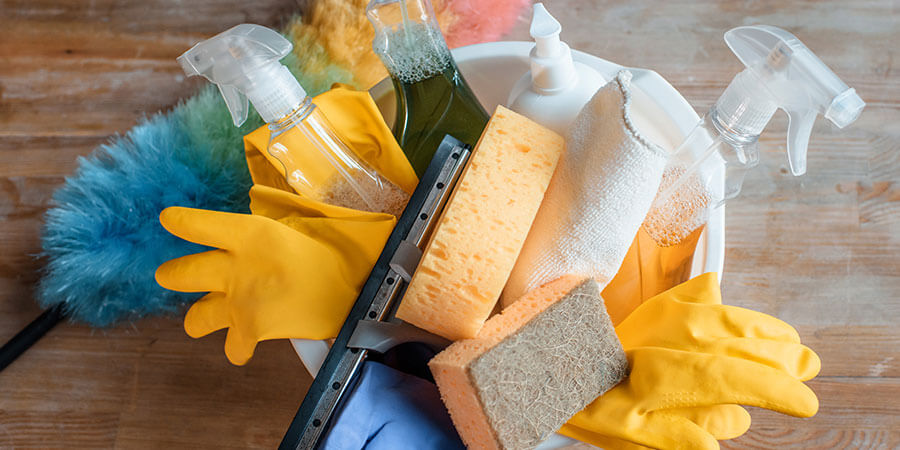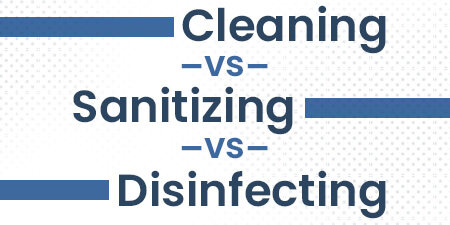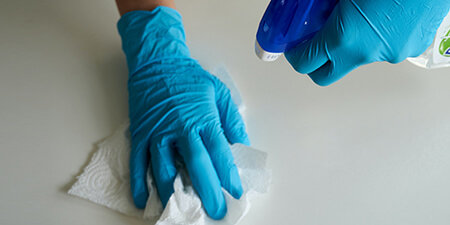Cleaning, Sanitizing, & Disinfecting: What's the Difference?

Keeping your restaurant clean and sanitary has always been important, but now it’s needed more than ever. To attract customers during the COVID era, it’s crucial to maintain a safe environment. This is more than appearances: your restaurant always looks clean, but is it properly sanitized and disinfected? What is the difference between cleaning and sanitizing?
The right products can help you make sure all three are taken care of. Keep reading to learn the difference between cleaning, sanitizing, and disinfecting, and how you can use all three to keep your restaurant in tip-top shape.
Know the Difference
So, are you cleaning, sanitizing, or disinfecting? It’s important to understand what each method accomplishes — and how it all contributes to your restaurant’s safety and efficiency. Let’s break it down:
Cleaning focus on surface-level appearances. It’s all about removing dust, debris and dirt from the surface by wiping, scrubbing, washing, and/or rinsing. These substances are not harmful to public health — just unsightly. However, if left unchecked, they can contribute to the growth of pathogens and mold. Ultimately, cleaning is just a means of removing surface films and contaminants from the environment.
Sanitizing reduces the growth of harmful bacteria that are left behind from meat juices, human contact, and general exposure to the elements. It is a way to minimize food-borne illness transmission and keep people from getting sick. However, it does not kill all of the viruses on the surface. Sanitizing is meant to be used as a preventative measure, not a reactive solution.
Disinfecting is the most intensive form of surface treatment. It kills specific viruses and pathogens using a specialized disinfectant. This is more than wiping them away: the microbes are eradicated by the chemicals used in disinfection. To be considered disinfectants, cleaning agents must kill 99.999% of infectious bacteria, viruses, and fungi within a 5-10 minute period. The most common bleach, chlorine, and alcohol.

Which One Should I Use And When?
Cleaning, sanitizing, and disinfecting are key elements of the same comprehensive safety routine. It’s important to consistently use all three hand-in-hand in order to keep your restaurant safe. Still, wondering what is the difference between cleaning and sanitizing?
Think of it this way: cleaning removes dirt and grime, sanitation cleans microbes, and disinfection prevents illness. Here’s a guide to what you should be cleaning, sanitizing, and disinfecting:

Cleaning
You should clean pretty much every surface in your restaurant, especially commonly touched surfaces and those that tend to accumulate debris. Most surfaces can be thoroughly cleaned by wiping them down, rinsing them off, or scrubbing them if needed.
Make the following part of your cleaning schedule:
- Tables
- Counters
- Appliances
- Point of Sale Systems
- Door Handles
- Floors
For helpful products that can make your cleaning routine a breeze, check out GoFoodservice’s selection of janitorial supplies.

Sanitizing
Anything that comes into contact with food should absolutely be sanitized regularly. This is crucial to preventing cross-contamination that may cause food poisoning and allergy problems. Most foodborne illnesses are bacterial, e.g. salmonella, so always be sure that your kitchen’s food prep surfaces and utensils are sanitized. This is especially important when preparing meat.
Make the following part of your sanitation schedule:
- Utensils (knives, serving utensils, etc.)
- Pots and pans
- Workspaces
- Cutting boards
- Cooking equipment
- Dishes
For food-safe, industrial-grade cleaning products, check out GoFoodservice’s selection of sanitation solutions and tools.

Disinfecting
COVID-19 is caused by a virus that can linger on surfaces for hours — and it’s not the only one. You should pay extra attention to high-touch surfaces, especially surfaces that both your customers and your staff are touching in addition. Disinfect these surfaces at least once a day — and much more often as long as the COVID pandemic lasts, during flu season, and anytime there is a virus outbreak.
Make the following part of your disinfection schedule:
- Bathroom surfaces (countertops, faucets, light switches, etc.)
- Tables
- Seating and chairs
- Menus
- Point-of-sale devices
To sanitize vs. disinfect is to remove potentially infectious bacteria versus eradicate harmful viruses. Disinfection is simply more comprehensive, which is crucial to operating your restaurant successfully during the pandemic. Tip: Be sure that you use products correctly. Some require a certain duration or intensity of use to achieve results!
How Can GoFoodservice Help?
So, what products do you need to keep your restaurant clean and sanitized? To start, you need something to remove dust and grease. Then, you can tackle surface bacteria and the grime that gives it a place to grow. Finally, you kill all viruses that could be transmitted to your customers, whether in the air or on surfaces. This three-prong strategy keeps your restaurant safe and sanitary.
No matter how big or small your establishment is, GoFoodservice has the tools you need to keep your restaurant clean and safe place — for both your customers and staff. With brands like Bissell, U.S. Chemical, Alpine Industries, and MARS air systems, we are able to provide a wide variety of cleaning, sanitizing, and disinfecting solutions.
Share This!